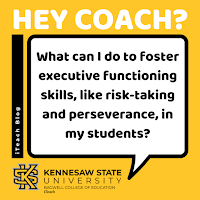Fostering Risk-Taking and Perseverance
Hey Coach,
 I have noticed a trend in my classroom - my students shy away from challenging tasks that require them to step out of their comfort zone! I want to create an environment where students feel comfortable taking risks and are willing to persevere through difficulties. What can I do to foster these skills in my students right from the start of the school year?
I have noticed a trend in my classroom - my students shy away from challenging tasks that require them to step out of their comfort zone! I want to create an environment where students feel comfortable taking risks and are willing to persevere through difficulties. What can I do to foster these skills in my students right from the start of the school year?
Sincerely,
Ready for Risk-Taking
Ready for Risk-Taking
Dear Ready for Risk-Taking,
Way to go! I like that you are thinking about how you can support your students as they build these important executive functioning skills! As you know, covering content and standards is just part of the equation. Building executive functioning skills like perseverance and risk-taking are a critical piece of academic success. Research shows that grit, or the ability to persevere when faced with obstacles, is one of the key principles that influence student learning and predict student success (Duckworth & Peterson, 2007).
Design challenges offer students excellent opportunities to take risks and learn from mistakes. Though they can be used at any time, they are great for the beginning of the school year when students are just getting to know each other and you. These activities have many names - maker challenges, brown bag challenges, engineering challenges - but at the heart of each is that we are offering students a challenging task that they work collaboratively to solve using a designated set of materials within a specific amount of time.
Success is not easy. Testing new ideas, experiencing failure, and reflecting on these experiences to refine thinking and improve performance are all integral parts of the learning process and are critical to building grit.
It’s easy to get started! First, download our Design Challenge Task Cards, featuring these activities:
- Marble Run - Build a free-standing marble run that allows the marble to travel at least 24 inches
- Pom-Pom Launcher - Build a device that will launch a pom pom as far as possible
- Build a Bridge - Build a bridge that spans 18 inches and supports the weight of eight matchbox cars
- Self-Propelled Vehicle - Build a self-propelled vehicle using recycled materials, a balloon, and rubberbands
- Cardboard Critter - Build a three-dimensional animal from cardboard that can move in some waySpaghetti Tower - Build the tallest tower possible that will support a marshmallow at the top
Then, simply gather the materials, group your students, set a timer, and let your students get to work on the task!
If you love these activities, you can find more challenges from Teach Engineering, PBS Design Squad, and the Cooper-Hewitt Museum.
After students complete a design challenge, don’t forget to debrief on the experience with your class. Invite students to share their mistakes, what they learned from them, and how they might improve next time.
The opportunity to reflect is critical for developing students’ executive functioning skills. Lee Carlton of the Think Global School states: “... reflection allows our students to engage in critical and reflective thinking, while also helping them to better process their experience and outcomes.” Reflection builds metacognition and gives students a tool they will use both in and out of the classroom.
Instead of just focusing on success, shift the conversation to celebrate the struggle that students worked through and the perseverance they displayed. Utilizing activities like these design challenges in our classrooms reframes the way we think about facing challenges and experiencing failure, helping students see failure for what it truly is - an opportunity to iterate, learn, and try again.
To learn more about the importance of executive functioning and metacognition in the classroom check out this white paper by Dr. Anissa Lokey-Vega and Stephanee Stephens: Personalized Learning in Georgia K-12 Schools.
Until next time,
Your iTeach Coach
Contributors: Anna Bilyeu and Ana Hale


Comments
Post a Comment